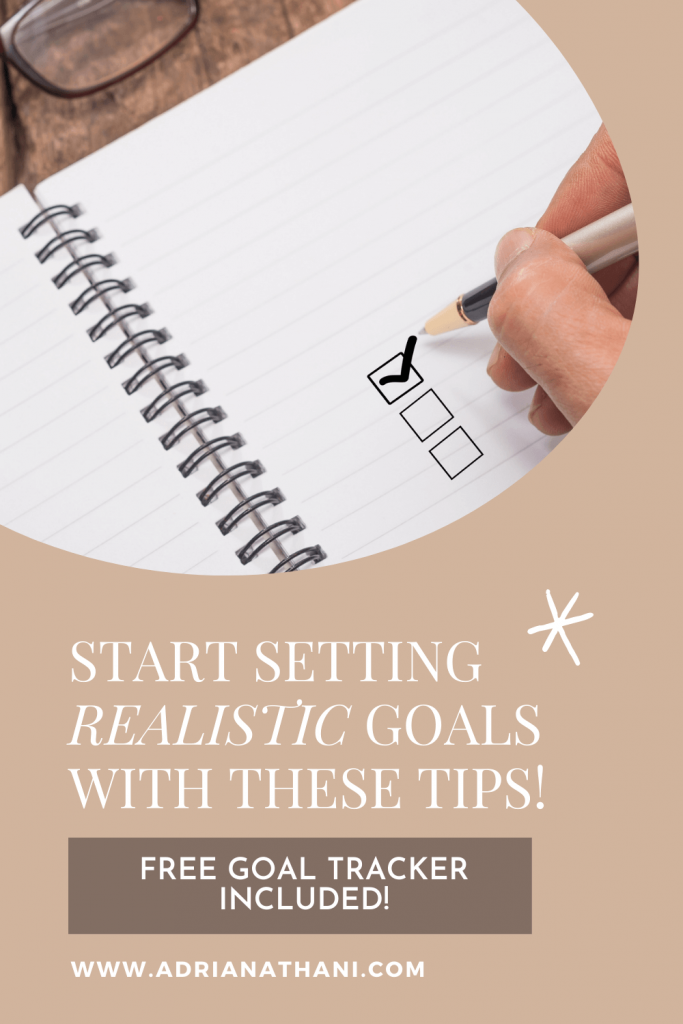Please note: This post may contain affiliate links that at no additional cost to you, I may earn a small commission. I only recommend products I would use myself and all opinions expressed here are my own.
Like most of you, I begin each year with the need to symbolize new beginnings by creating a list of the different goals I want to achieve in the next 12 months.
Also like most of you, this list is often very long, very ambitious, and very much unachievable!
After the existential hellscape that was 2020, I decided that I wanted to set more realistic and achievable goals this year. As part of my mission to be more intentional in all areas of my life, I have been focused on being mindful of my own strengths, limitations, and support network throughout this entire process.
I’ve personally been using the following techniques to really get the most of my goal-setting process this year. If you want to make this year more productive, read on to discover the nine ways I’ve been setting realistic goals!
9 ways I set realistic goals for myself
Everyone thinks differently and responds to different approaches, which means what works for me might not work for you. However, I think it’s still important to try.
If what you’ve been doing so far works for you, then you’re all set! But if you find yourself lacking motivation or feeling discouraged in achieving your goals, I suggest you try a few (or all) of these ideas to see if something really resonates with you.
Remember, these are real goals that I’ve set for myself this year, so while the examples themselves may be totally different from yours, they’re merely there to help illustrate the techniques!

1. Only focus on a maximum of three big goals at a time
This seems to defeat the purpose of new year’s resolutions, right? Surely you’ve gotta go big and tackle 50 things at once!
The thing is, when was the last time you managed to multi-task even just three things at once? Even if you did manage to do it, did you do it well?
I decided this year that I wanted to focus on quality, not quantity. My three big goals are focused on three different areas of my life that I want to improve, and once each goal has been achieved, I will be ready to tackle the next big goal.
Working towards a smaller number of goals means that I am making more progress with each goal, in a shorter amount of time. This then motivates me to keep at it. And when I do achieve those goals, it feels so rewarding that I look forward to starting on the next goal!
So try whittling your immediate goals down to just three, and leave the rest of your goals on a master list somewhere else to consult later.
Here are my big three goals for now:
– Achieve peak stamina
– Develop new, deep friendships
– Create a personal brand I can be proud of
These are all fairly vague, but I do break down each one into the actual steps and processes required to achieve them, which I’ll explain further down!
2. Find the purpose behind each goal
Go deeper with the goals by asking yourself exactly why each goal is so important to you. Reflect on what is valuable to you specifically, not what is defined as ‘valuable’ by everyone else.
Here’s the harsh truth: when achieving your goals isn’t driven by a deeper motivation, it’ll be tough to keep pushing through the tough bits. Finding your ‘why’ is going to keep you motivated!
If you find that you can’t really find a compelling reason to set up a goal, then don’t even waste your time on it. Give yourself a chance to focus on goals that actually matter to you.
For example, in the past, I would usually set a goal to reduce my dress size or get down to a certain weight. But as someone who is working on body neutrality and developing a realistic body image, these goals simply don’t sit right with me. Sometimes the thought actually makes me feel nauseous, because it goes against my beliefs surrounding body image.
So this year, I’ve decided to shift the focus on prioritising movement for stamina instead. It’s amazing how this shift in perspective has worked so far! Since I’m focused on this specific benefit of staying active, I’ve managed to create goals surrounding the duration and intensity of each workout instead of a number on my clothing tag or weighing scale!
Here’s what this goal looks like:
By June 2021, I want to be able to complete 1 hour of Zumba without quitting.
It’s so much more effective for me to focus on trying to achieve a result that actually matters to me and is more in line with my beliefs.

3. Define goals based on your abilities and limitations
Look, nobody likes to confront their weaknesses. But it’s so important to address your abilities and limitations (AKA strengths and weaknesses) so you can set goals that are realistic and achievable!
If you can’t be honest with yourself about how much time and effort you can commit to achieving your goals, you are setting yourself up for disappointment. This, of course, will set you on a downward spiral of self-pity and loathing.
Stop doing that to yourself!
This year, be frank with yourself about what you can realistically invest into your goals. Achieving goals takes resources – time, energy, motivation, and even finances – so take inventory of all that and be extra mindful of your limits when you’re setting your goals.
Here’s what that looks like for me:
Instead of “Go to the gym 5 days a week”, my goal is to “Be able to complete an hour of Zumba”. Instead of “Go out for coffee with friends twice a week”, my goal is to “Have at least three conversations with friends every day”.
Achieving my goal is not based on showing up somewhere that may get shut down again because of a pandemic. It’s not based on how often I can go out to coffee with my friends.
Instead, it’s based on what I know to be my abilities and limitations in working towards that goal. It means that I will continue exercising every day, whether or not I go to the gym. It means I will find pockets of time during school pick-ups and waiting for my kettle to boil, to simply drop a quick message to a friend to see how they’re doing.
Putting the responsibility on my own abilities keeps me accountable and keeps me honest about my own limitations. It also allows me to get creative about the strategies I’ll take to reach every goal.

4. Anchor new habits to existing ones
Right, if you know me long enough, you’ll know by now that I am a big believer in anchoring new habits to old ones, which is sometimes known as habit stacking.
The reason this technique works so well is that you’re already doing the anchor activity on autopilot. It’s already an established part of your routine. So attaching a new habit related to your goals is an easy way to make sure you do it!
Here’s what that looks like for me:
“In order to get some exercise in, I will use my stepper whenever I want to scroll through Instagram and Facebook”
It sounds ridiculous, but it works! I’ve had more time on that stepper in the last month than I’ve had in the last 3 years I’ve owned it. While this points to me perhaps using social media way too much (I work in the field, it’s a job hazard!), it also helps me achieve my goals without me even noticing the effort.
Before you know it, your brand new habit will be an established part of your routine!
5. Keep goals holistic
If you take nothing else away from this blog post, I want you to remember this: You are a whole person.
You’re not just a body that needs to be fit and healthy, you’re not just a brain that needs to stay sharp, you’re not just a caregiver who needs to remain dependable – you are all of these things and more.
Your goals should reflect that.
When I focus on whole person development, it means that I value every facet of my identity and wellbeing. This motivates me to work on fulfilling my physical, mental, emotional, and spiritual needs. It’s about balancing all of these parts of me and not placing far too much importance on one single thing.
Here’s what this means for me:
I want to achieve peak stamina so my healthy body can catch up with my kids. I want to have deeper friendships with new friends because I know being social is important to my mental health and well-being. I want to commit to developing my personal brand because I want to leave a legacy I can be proud of.
This year, I’ve made sure all my goals come together to nourish every part of me, so I can emerge next year as an improved version of my whole self.

6. Write it down!
Did you know that you are 42 percent more likely to achieve your goals if you write them down on a regular basis? So if you haven’t been writing down your goals, you need to start doing that right now!
You should also take the time to define the key milestones in achieving your goals. The Mission Statement section of my Saint Belford Curation Planner includes a little section for each of my big goals, where I can write down the key milestones and colour in the progress at each point. Such a small detail, but hey, every dopamine hit counts!
Why is it so important to write down your goals and milestones? Well, it:
- Keeps you accountable
- Reminds you of your purpose
- Allows you to identify where you need to adjust your strategy and get creative
- Makes you crystallise each goal and whittle it down to the basics over time
It might even make you more aware of how much or how little you value a goal, giving you an opportunity to find a goal that’s actually valuable to you.
I love my Saint Belford Curation Planner because it makes writing my goals so easy! There’s even sections within my weekly planning pages where I can write down the tasks that I need to accomplish each week, so I am constantly thinking about my goals. Writing down my goals (and mini-goals) is just a part of my daily routine now!
Use code ADRIANA to get your own Saint Belford Curation Planner 10% off! Shop here.
7. Improve on the things you’re already doing
Who says your goals need to be started from scratch? If you have a goal you’ve already achieved, keep finding ways to elevate it. There is value in this continuous improvement, particularly if it motivates you to do more of what’s good for you!
For example, I’ve already achieved a number of small goals in developing my personal brand, but there was never any structure to my approach. So this year, I decided to really buckle down and create realistic goals that are part of a larger strategy.
It’s fun because I’m using skills and experience I already have, so it doesn’t feel too difficult. But I’m still taking extra steps and being more intentional in how I’m using my existing skills to achieve this goal, and that can be challenging!
So here’s how this looks for me:
I will post more frequently and consistently on Instagram. I will have a monthly editorial calendar containing all my content creation and scheduling. I will focus on the specific topics of personal development, wellness, and self care.
There’s heaps more examples I could think of, but that’s an example of the few things I already knew how to do and am taking to the next level this year!

8. Tell people about it
If you’re anything like me, this one’s tough. I generally play my cards close to the chest, and this attitude is deeply rooted in my fear of failure.
What I’ve learned is that sometimes this mindset can actually contribute to failure, because it’s a reflection of the lack of confidence we have in ourselves!
So now I have made an effort to share my progress – which includes all the highs and lows – because I want people to keep me accountable and also provide much-needed support when times get rough.
A great example of this:
Through all of February 2021, I’m doing a #28DaysOfAffirmations2021 challenge. I’ve been sharing my daily affirmations and my thoughts around them for four whole weeks on Instagram for the world to see. My friend, it has been daunting. But I’ve shared the good days and the bad days, and guess what? People still applauded me for showing up and being vulnerable.
Now, before you say it – no, you don’t have to do a full Instagram challenge or blog post about your goals!
But you could tell a couple of people close to you – your partner, your best friend, or maybe even a sibling. Just make sure you’re telling someone who is genuinely supportive and has your best interests at heart. Someone who knows what it takes to keep you motivated and accountable. Someone who would make an honest and reliable accountability partner.
You should also consider what type of support you actually need.
Does tough love work for you? Then share your goals with someone who will kick your butt into gear when you’re slacking off.
Do you prefer a gentler approach? Then tell someone who always has a knack for choosing the right words of encouragement.
With the right person – or group of people – by your side, you’ll be kicking those goals in no time!
9. Narrow it down to monthly or weekly goals
Alright, I’ve saved the best for last!
The single most impactful way you can set realistic goals for yourself is to break it down into daily or weekly goals. It is so much easier to remain motivated and accountable when you have mini-goals set in the immediate future, trust me on this!
This concept is very popular in personal finance and budgeting communities. Let’s say you set an annual goal for your savings – pretend it’s $6,000.
This means you’ll have a monthly savings goal of $500. You can break that down to a weekly goal of $115, or even further down to a daily goal of $16.
Do you see how much more realistic and achievable this sounds? It’s much easier for us to consistently focus on these smaller goals than it is to try and stay focused on a goal with a deadline that’s months away.
Here’s an example from my own goal-setting process:
My big goal for the next 6 months is to produce 30 blog posts. I figured out that I would need to produce at least 5 blog posts a month – which is roughly one blog post a week – to reach that goal.
The thought of 30 blog posts is overwhelming, right? I mean, that involves writing anywhere between 30,000 to 60,000 words in total! But once I broke it down to a weekly goal, it’s transforms into a truly easy-peasy and 100% achievable goal.
![]()
How about a Goal Tracker worksheet to help you break down your goals?
I know that it can be tricky to figure out exactly how you’ll realistically narrow down your larger goals into more manageable monthly or weekly goals, which is why I’ve created a FREE printable Goal Tracker worksheet that you can use to figure out just that! It will help you break down your long-term goals into smaller, actionable steps.
Use the top section to define your big goals – for example, your goals could be:
- Run a half-marathon in 6 months
- Save $2500 by September to book a year-end holiday
- Finish knitting a sweater by winter time
Now your monthly goals would be:
- Run 3.5km by February, 7km by March, 10.5km by April (and so on, till you get to 21km!)
- If you’re planning to start saving by February, you need to save $416 a month to book your trip in early September
- Let’s say you’re a beginner knitter – perhaps you can spend the first month learning to make a simple scarf, then the next two months making a tote bag, and then spend the following months making your first sweater! (I highly recommend The Flax Sweater by Tin Can Knits if you want to take on this goal)
Let’s break these goals down even further into weekly or daily goals:
- Accomplish 500m more distance in your run each week of your half-marathon training – so 500m for Week 1, 1km for Week 2, 1.5km for Week 3 (and so on)
- Save $16 a week for 26 weeks (AKA 6 months)
- Knit at least 3-5cm a day
Remember, you are much more likely to achieve your goals when you write them down! Click here or scroll down to download my free Goal Tracker Worksheet.
(You’ll notice there’s a section for your monthly affirmation too, which I highly recommend you use! You can find out more about the power of positive affirmations in my previous blog posts about how to practice them daily and how to incorporate positive affirmations in your life).
It’s time to create goals you can actually achieve!
It is so much easier to stay motivated and focused when you set realistic goals for yourself. Whether you’re looking to improve your mindset, health, spirituality, productivity, or relationships, do yourself a favour and create realistic and achievable goals from now on. It’ll make you enjoy the process – and celebrate your progress – along the way!
Are you looking for inspiring content about personal development, goal-setting, productivity, self-care, and mindfulness? Subscribe to my fortnightly newsletters to get this content right in your inbox every other week!
You’ll also be the first to find out about brand partnerships, special offers, and exclusive content – sign up now so you don’t miss out:

Subscribe now!
You’ll receive a FREE printable Goal Tracker so you can easily track your monthly and weekly goals in a single page.
You’ll also receive empowering and inspiring content around personal development, goal setting, self-care, and wellness, right in your inbox every two weeks!
Thank you!
You have successfully joined my subscriber list.










28 thoughts on “How To Set Realistic Goals: 9 Simple and Effective Ways To Do It ”
SMART goals! We know we should set reasonable goals but we fail to put these into practice. Routine –> habit!
Routine –> habit! YES! You nailed it right there! Thanks Andrea 🙂
– Adriana
Good tips!
Thanks Akshita! Hope they help you reach your goals 🙂
– Adriana
Never heard of habit stacking but it sounds like it really could work. I’ve slowly ratcheted up my post per week. Thx.
It’s definitely one of my all-time favourite techniques for developing new habits 🙂
– Adriana
My favorite part is keeping it holistic. Thanks for sharing.
It took some time for me to come to that realization, but now that I focus on my whole person development, it’s really made a big difference to my mindset and goals! Thanks for reading, LaRena 🙂
– Adriana
This is such a drive to get through these unprecedented times! Feeling motivated😍
Thank you, Pranee! I’m so glad it helped you get motivated! Realistic goals definitely can do that, haha.
– Adriana
A great reminder of how to be realistic about our goals. I appreciate it a lot!
I’m glad you found it helpful! I’m all about being realistic when it comes to goals 🙂
Wow, you present some really valuable points here! From forming habits (the right way) to finding the meaning behind your goals, limiting the amount you set and breaking them up in smaller goals. You can’t go wrong if you implement these steps, thanks for sharing!
Hey Joep! Thank you, I’m so glad you found it helpful!
– Adriana
I love the tip to expand on what you’re already doing! Sometimes new goals can be scary but if it is just a stretch on something you are already doing, you will be more likely to achieve it!
Spot on, Erica! Setting up goals around things you’re already doing is a totally valid way to develop and grow. It doesn’t have to be a completely brand new thing!
– Adriana
Anchoring new habits to existing ones is actually one of my goals. Habit stacking works for me in other areas and I’m trying to make it work in others.
It’s such a simple concept, but I’ve found it to be the best technique for developing new habits and (more importantly) making them stick!
– Adriana
Thank you for these super practical ideas!
I’m glad you found them helpful, Bethany!
– Adriana
These are great tips! I love the way you laid it out and gave examples!
Thank you for your kind words, Candace! I really do appreciate it. I hope you found it helpful in achieving your goals!
– Adriana
This is a great post! I’m an avid goal setter and use many of these strategies. Thanks for sharing!
Hello, fellow avid goal setter! It’s so much easier to stay motivated when I’m intentional about my (realistic!) goals. Thanks for reading, Tracy x
– Adriana
Wow! Very thought-out article! Lots of wonderful ideas! Thanks for sharing!
Thanks, Susan! I hope you find it helpful 🙂 Thanks for sparing the time to read!
– Adriana
Great post. I think it’s all about the mindset around your goals and you’ve got some great tips! Thanks.
You are so right! It’s all about mindset. That’s why it helps to be really intentional with setting goals. Thanks for reading!
– Adriana